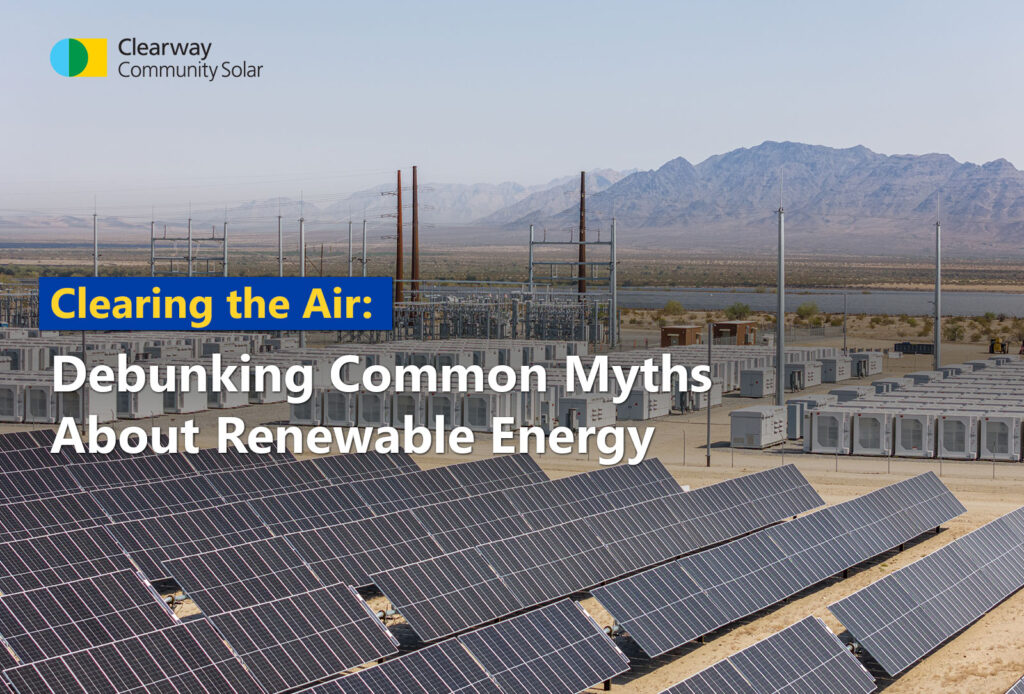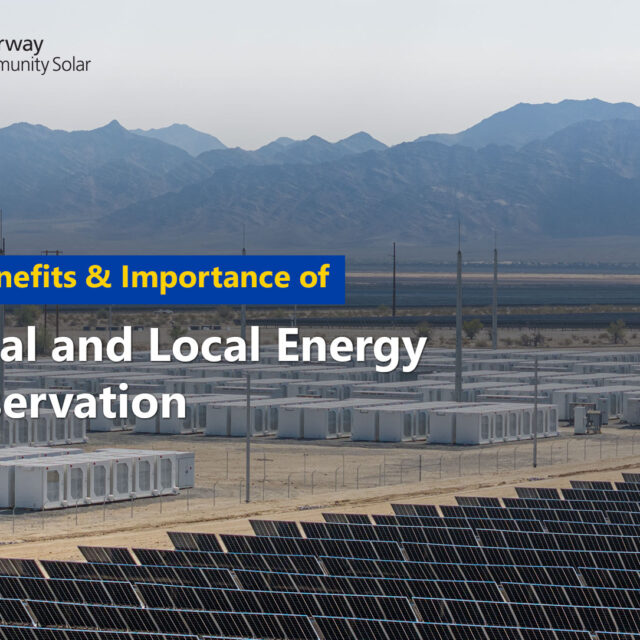
Renewable energy comes from natural sources that can be replenished, like sunlight, wind, water, and geothermal heat. As we face the challenges of climate change and strive for energy independence and net-zero carbon emissions, renewable energy is more crucial than ever. It not only helps cut down greenhouse gas emissions, but it also lowers energy costs and supports a more sustainable future. Embracing these clean energy sources can make a big difference for our planet and our communities.
Some common types of renewable energy include:
- Solar energy
- Wind energy
- Hydropower
- Geothermal energy
- Biomass energy
- Battery energy storage systems
Despite the growth of renewable energy, many myths persist. These misconceptions can lead to confusion and hesitation in adopting clean energy solutions. Let’s debunk some of the most common myths surrounding different types of renewable energy and instead look at the facts.
Solar Energy Myths Debunked
Solar energy harnesses sunlight to generate electricity. As solar power technology becomes more popular, various misconceptions have emerged.
Myth 1: Solar Energy Doesn’t Work in Cloudy or Cold Climates
The Truth: Solar panels can still generate electricity even on cloudy days. They capture indirect sunlight, making them effective in a variety of weather conditions. In fact, even areas with less sunlight have been successful in implementing solar energy.
- Related article: Solar Panels and Cloudy Skies
Myth 2: Solar Energy Is Too Expensive and Only for the Wealthy
The Truth: The cost of solar energy has dropped significantly over the past decade. Many financial incentives, such as tax credits and rebates, make solar installations more affordable for everyone, not just the wealthy. Community solar programs also allow people to invest in solar energy without installing panels on their roofs.
- Related article: How Pricing Works – Earn Solar Bill Credits That Reduce Your Charges
- Related article: Navigating the Hidden Costs of Rooftop Solar Panels
Myth 3: Solar Panels Aren’t Environmentally Friendly Due to Their Manufacturing
The Truth: While the production of solar panels does have an environmental impact, it’s minimal compared to the benefits of using solar energy. Over their lifetime, solar panels produce far more clean energy than the energy required for their manufacturing.
Wind Energy Myths Debunked
Wind energy is generated by harnessing the power of wind through turbines. Several myths surround this renewable resource.
Myth 1: Wind Turbines Are Harmful to Birds, Whales, and Other Wildlife
The Truth: Wind turbines do pose some risk to birds, but research shows they are far less harmful compared to other threats like habitat destruction and pollution related to fossil fuel extraction. Efforts are being made to design safer turbines and to place them in locations that minimize risks to wildlife.
Concerns have been raised about the impact of offshore wind development on migratory marine mammals, like whales. While there may be some noise and temporary habitat disruptions during construction, ongoing research and planning are helping to reduce these risks. There are also regulations that require assessments to minimize harm to marine life, and NOAA provides guidelines to limit noise pollution and protect species. The NOAA and the Bureau of Ocean Energy Management have even begun working together to reduce impacts on endangered whales.
Myth 2: Wind Power is Inconsistent and Can’t Reliably Provide Electricity
The Truth: While wind energy is variable, advancements in technology allow for better prediction and integration into power grids. Combining wind with other energy sources helps ensure a steady supply of electricity.
Myth 3: Wind Turbines Are Noisy and Harmful to Human Health
The Truth: Modern wind turbines are designed to operate quietly, and studies have shown they do not pose health risks to nearby residents. The noise levels are often comparable to that of a refrigerator.
Hydropower Myths Debunked
Hydropower generates electricity from flowing water. While it can be a great option, some people believe it is harmful to the environment, unreliable, and ineffective. See the myths below.
Myth 1: Hydropower Destroys River Ecosystems and Displaces Communities
The Truth: While hydropower projects can impact ecosystems, many modern projects use technologies that minimize these effects. Sustainable practices are in place to protect both wildlife and local communities.
Myth 2: Hydropower Is Not a Reliable Source Due to Droughts
The Truth: Droughts can affect hydropower, but many plants can store water to manage variations in supply. Additionally, a diverse energy portfolio and relying on more than one renewable energy source in an area can balance the impact of drought.
Myth 3: Hydropower is Obsolete Compared to Solar and Wind
The Truth: Hydropower remains one of the most reliable and consistent sources of renewable energy. It plays a crucial role in many countries’ energy strategies, complementing solar and wind.
Geothermal Energy Myths Debunked
Geothermal energy uses heat from the Earth to produce electricity. From earthquakes to pollutants, there are several myths about geothermal energy that are not true.
Myth 1: Geothermal Energy Can Only Be Used in Specific Areas
The Truth: While geothermal energy is most accessible in volcanic regions, advancements in technology are making it possible to harness geothermal energy in more areas than ever before.
Myth 2: Geothermal Energy Causes Earthquakes
The Truth: Geothermal energy does not cause earthquakes. While some drilling activities can induce seismic activity, it is usually minor and carefully monitored to avoid significant events.
Myth 3: Geothermal Plants Disrupt the Environment and Release Pollutants
The Truth: Geothermal plants produce very low emissions compared to fossil fuels. They are designed to minimize environmental impact and often restore the surrounding ecosystem.
Biomass Energy Myths Debunked
Biomass energy is an increasingly common form of renewable energy. Although it has proven to be effective, some people have misguided concerns about deforestation, wastefulness, and more.
Myth 1: Biomass Energy is Just as Harmful as Fossil Fuels
The Truth: Biomass energy can be much cleaner than fossil fuels. In fact, when sourced sustainably, it can help reduce waste and lower greenhouse gas emissions.
Myth 2: Biomass Energy Contributes to Deforestation
The Truth: Sustainable biomass energy relies on careful management of forests and agricultural practices. When done responsibly, it can actually promote reforestation and soil health.
Myth 3: Biomass is Inefficient and Wasteful
The Truth: Biomass energy is a highly efficient process. Advances in technology are making it even more efficient, and it often uses waste products that would otherwise go to landfills.
Battery Energy Storage Systems Myths Debunked
Battery energy storage systems are essential for storing renewable energy. From potential hazards to pollution, here are some of the common myths:
Myth 1: Batteries Are Dangerous and Prone to Fires or Explosions
The Truth: While there are safety concerns, modern batteries used for energy storage are designed with safety features to prevent such incidents. Proper handling and technology significantly reduce risks.
Myth 2: Batteries Pollute the Environment Through Leaks or Emissions
The Truth: Batteries are subject to strict regulations to minimize environmental impact. Recycling programs are also in place to manage waste and reduce pollution.
Myth 3: Batteries Have Short Lifespans and Create Waste
The Truth: Modern batteries have longer lifespans than ever, and recycling efforts help reclaim valuable materials, reducing waste and promoting sustainability.
General Renewable Energy Myths
Not all myths are specific to one type of renewable energy. Let’s explore some of the more general renewable energy myths that have come onto the scene in recent years.
Myth 1: Renewable Energy Can’t Replace Fossil Fuels Completely
The Truth: While transitioning to renewable energy will take time, advancements in renewable energy technology, such as improved solar cell efficiency, better energy storage technology, and more, are making it increasingly feasible to reduce reliance on fossil fuels.
Myth 2: Renewable Energy is Unreliable Without Fossil Fuel Backup
The Truth: As technology improves and energy storage solutions advance, renewable energy is becoming more reliable and competitive. Combining various sources of energy creates a more stable power supply.
Find Reliable Clean Energy Resources
At Clearway Community Solar, we believe in a clean energy future. And we believe that doing your part shouldn’t be hard or a hassle. It should not be costly or overly complex.
That’s why we’ve designed a solar energy program that makes supporting renewable energy both accessible and practical. In short, we make renewable, reachable. We make it easy to do your part. We help communities transition to sustainable energy sources while offering resources to educate and empower individuals about renewable energy.
Together, we can clear the air and embrace a sustainable future. Let’s all do our part to stay educated, help debunk myths, and embrace the truth about renewable energy!









